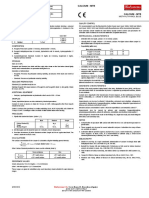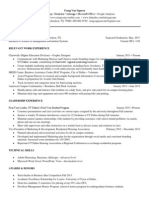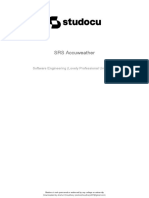GAMMA-GT Carboxy GPNA: Biolabo
Uploaded by
Fariz KasyidiCopyright:
Available Formats
GAMMA-GT Carboxy GPNA: Biolabo
Uploaded by
Fariz KasyidiOriginal Description:
Original Title
Copyright
Available Formats
Share this document
Did you find this document useful?
Is this content inappropriate?
Copyright:
Available Formats
GAMMA-GT Carboxy GPNA: Biolabo
Uploaded by
Fariz KasyidiCopyright:
Available Formats
BIOLABO
www.biolabo.fr
GAMMA-GT carboxy GPNA
MANUFACTURER: Reagent for quantitative determination of
BIOLABO SAS,
Gamma Glutamyltransferase activity [ EC 2.3.2.2 ] in human serum and plasma.
Les Hautes Rives
02160, Maizy, France
REF 81110 R1 8 x 30 mL R2 8 x 30 mL
REF 81210 R1 1 x 105 mL R2 10 x 10 mL
REF 81310 R1 10 x 100 mL R2 10 x 100 mL
|
TECHNICAL SUPPORT AND ORDERS
Tel: (33) 03 23 25 15 50
IVD IN VITRO DIAGNOSTIC USE
Fax: (33) 03 23 256 256
CLINICAL SIGNIFICANCE (1) (2) REAGENT PREPARATION
Even though renal tissue has the highest level of γ-glutamyltransferase Use a non-sharp instrument to remove aluminium cap.
(GGT), the enzyme present in serum appears to originate primarily REF 81210: Add promptly 10 mL of vial R1 (Buffer) into the contents
from the hepatobiliary system. GGT activity is elevated in any and all of vial R2 (Substrate).
forms of liver disease. It is highest in cases of intrahepatic or
posthepatic biliary obstruction. It is more sensitive than ALP and Others REF: Dilute the contents of vial R2 (Substrate) with approx.
transaminases in detecting obstructive jaundice, cholangitis and 10 mL of vial R1 (Buffer), transfer into vial R1 (buffer).
cholecystitis. Only moderate elevation occurs in infectious hepatitis, Mix gently and wait for complete dissolution before using reagent
chronic alcoholism or drugs use (sedatives, anticonvulsants,and (approximately 2 minutes).
tranquilisers). Decreased GGT activity is found in case of
hypothyroidism.
In summary, GGT is the most sensitive enzymatic indicator of STABILITY AND STORAGE
hepatobiliary disease available at present but doesn’t allow Store away from light, well cap in the original vial at 2-8°C
discriminating between different kinds of liver disease. • Unopened, reagents are stable until expiry date stated on the label
of the kit when stored and used as described in the insert.
PRINCIPLE (4) (5) • Once reconstituted, working reagent is stable for 30 days when free
Szasz, Rosalki and Tarlow method. Reaction scheme is as follows: from contamination.
• Discard any reagent if cloudy or if reagent blank at 405 nm > 1.000
L-G-Glutamyl-3-carboxy-4- GGT L-G-Glutamyl-glycylglycine
nitroanilide • Don’t use working reagent after expiry date stated on the label of the
+ p-nitroaniline
+ Glyc ylglycine Kit.
The rate of formation of p-nitroaniline, directly proportional to SPECIMEN COLLECTION AND HANDLING (1) (2)
GGT activity in the specimen, is measured at 405 nm. Unhemolysed serum or EDTA-plasma (up to 1 mg/ml of blood).
Heparin produces turbidity in the reaction mixture; citrate, oxalate and
fluoride depress GGT activity by 10 to 15%.
REAGENTS COMPOSITION
GGT is stable in serum for:
Vial R1 BUFFER • 1 month at 2-8°C
• 1 year at–20°C.
Glycylglycine 100 mmol/L
TRIS pH 8.25 95 mmol/L
Preservative INTERFERENCES (1) (3)
Tests results on Kenza 240 TX:
Vial R2 SUBSTRATE Ascorbic Acid: No interference up to 25 mg/dL.
Total Bilirubin: Negative interference over 450 µmol/L.
L-G-glutamyl-3-carboxy-4-nitroanilide 80 mmol/L Glucose: No interference.
(Carboxy-GPNA) Haemolysis: Negative interference over 225 µmol/L.
Turbidity: No interference.
For a more comprehensive review of factors affecting this assay refer to
SAFETY CAUTIONS the publication of Young D.S.
BIOLABO reagents are designated for professional, in vitro diagnostic
use.
MATERIALS REQUIRED BUT NOT PROVIDED
• Verify the integrity of the contents before use.
• Nitroaniline derivatives (product of the reaction) are toxic. Do not 1. Medical analysis laboratory equipment.
inhale, do not ingest. 2. Normal and pathological control sera.
• Use adequate protections (overall, gloves, glasses).
• Do not pipette by mouth.
• In case of contact with skin or eyes, thoroughly wash affected areas CALIBRATION
with plenty of water and seek medical advice. Results will depend on the accuracy of the instrument calibration, the
• Reagents contain sodium azide (concentration < 0,1%) which may time counting, the respect of reagent/specimen ratio and the
react with copper and lead plumbing. Flush with plenty of water temperature control.
when disposing. • Use the theoretical calibration factor (§ CALCULATION)
• Material Safety Data Sheet is available upon request. • Or REF 95015 BIOLABO Multicalibrator (calibration value
• Waste disposal: Respect legislation in force in the country. determined with validated statistical techniques and metrologically
All specimens should be handled as potentially infectious, in controlled instrument)
accordance with good laboratory practices using appropriate • Or a multiparametric calibrator traceable to a reference method or
precautions. Respect legislation in force in the country. material.
Made in France Latest revision : www.biolabo.fr Revision : 19/06/2013
QUALITY CONTROL MANUAL PROCEDURE
• BIOLABO EXATROL-N Level I REF 95010 Let stand reagents and specimens at room temperature.
• BIOLABO EXATROL-P Level II REF 95011
• Other assayed control sera referring to the same method. Pipette into 1 cm path length thermostated cuvette:
• External quality control program.
It is recommended to control in the following cases: Reagent 1 mL
• At least once a run. Bring to 37°C (30°C) then add:
• At least once within 24 hours.
• When changing vial of reagent. Specimen or Calibrator 50 µL
• After maintenance operations on the instrument.
If control is out of range, apply following actions: Mix. Read initial absorbance after 30 seconds, record absorbance at 405 nm
1. Repeat the test with the same control. every minute during 3 minutes.
2. If control is still out of range, prepare a fresh control serum and Calculate absorbance change per minute (∆Abs/min).
repeat the test.
3. If control is still out of range, verify analysis parameters: Notes: Specific procedures are available upon request for
Wavelength, temperature, specimen/reagent ratio, time counting, automated instruments. Please contact BIOLABO technical
calibration factor. support.
4. If control is still out of range, use a new vial of reagent and assay
again
5. If control is still out of range, please contact BIOLABO technical CALCULATION
support or your local Agent.
Calculate the result as follows:
EXPECTED VALUES (5)
With theoretical factor:
Adult GGT activity, measured at 37°C
∆Abs./min.) x 2121
IU/L = (∆
Men (IU/L) 11-50
µkat/L = IU/L
Women (IU/L) 7-32
60
Each laboratory should establish its own normal ranges for the
population it serves.
With serous multicalibrator
GGT Activity = (∆Abs/min) Assay x Calibrator Concentration
PERFORMANCE CHARACTERISTICS (∆Abs/min) Calibrator
Tests Results on Kenza 240 TX:
REFERENCES
Within-run Normal Medium High Run to run Normal Medium High
(1) TIETZ N.W. Text book of clinical chemistry, 3rd Ed. C.A. Burtis, E.R.
N = 30 level level level N = 30 level level level Ashwood, W.B. Saunders (1999) p. 686-689.
Mean UI/L 43 104 329 Mean UI/L 46 111 363 (2) Clinical Guide to Laboratory Test, 4th Ed., N.W. TIETZ (2006) p. 470-473..
th
(3) YOUNG D.S., Effect of Drugs on Clinical laboratory Tests, 4 Ed. (1995) p.
S.D. UI/L 0.9 0.7 3.6 S.D.UI/L 1.3 2.5 10.8 3-296 à 3-300
C.V% 2.0 0.6 1.1 C.V% 2.7 2.3 3 (4) SZASZ G., Clin. Chem., (1969), 15, p.124
(5) SZASZ G., Bergmeyer H.U.,ed. Methods of Enzymatic analysis, (1974)
Criteria < 4.5% < 4.5% < 4% Criteria < 6% < 6% < 5% Weinheim Verlag Chemie
Detection limit: environ 4 UI/L
Sensitivity for 21 UI/L: environ 0,010 ∆Abs/min
Comparison studies with commercially available reagent:
y = 0.9387 x +2.214 r = 0,9985
LINEARITY
The assay is linear up to 320 IU/L (5.33 µkat/L).
Above, dilute specimen with saline solution and assay again taking into
account the dilution factor. Linearity will depend on the
specimen/reagent ratio.
IVD REF LOT →
Manufacturer Use by In vitro diagnostic Temperature limitation Catalogue number See insert Batch number Store away from light sufficient for dilute with
Made in France Latest revision : www.biolabo.fr Revision : 19/06/2013
You might also like
- Urea (Ned Method) : CODE NO. PACK SIZE Reagent 1 Reagent 2 Reagent 3No ratings yetUrea (Ned Method) : CODE NO. PACK SIZE Reagent 1 Reagent 2 Reagent 31 page
- Hazel Case: A. What Kind of Things Would Likely Require Forecasts?No ratings yetHazel Case: A. What Kind of Things Would Likely Require Forecasts?3 pages
- Alkaline Phosphatase: Colorimetric MethodNo ratings yetAlkaline Phosphatase: Colorimetric Method2 pages
- Aspartate Aminotransferase Ifcc Manual RX Monza Intended UseNo ratings yetAspartate Aminotransferase Ifcc Manual RX Monza Intended Use4 pages
- Auto Liquicolor: Photometric Test For Direct (D) BilirubinNo ratings yetAuto Liquicolor: Photometric Test For Direct (D) Bilirubin1 page
- TOTAL PROTEIN (Biuret Method) : Code No. Pack Size Reagent 1 Reagent 2100% (1)TOTAL PROTEIN (Biuret Method) : Code No. Pack Size Reagent 1 Reagent 21 page
- Biochemistry Control Serum (Human) : Level: II Lot: 033 EnglishNo ratings yetBiochemistry Control Serum (Human) : Level: II Lot: 033 English2 pages
- H-046-003257-00 FERRITIN KIT (CLIA) Muti LaguageNo ratings yetH-046-003257-00 FERRITIN KIT (CLIA) Muti Laguage15 pages
- ELISA Test For The Quantitative Determination of Total Thyroxine (T4) in Human SerumNo ratings yetELISA Test For The Quantitative Determination of Total Thyroxine (T4) in Human Serum2 pages
- CK-MB Liquiuv: Liquid Nac Activated Uv Test Creatine Kinase (Ec 2.7.3.2)100% (1)CK-MB Liquiuv: Liquid Nac Activated Uv Test Creatine Kinase (Ec 2.7.3.2)1 page
- Elecsys FT4 II: 06437281 190 Cobas e 411 Cobas e 601 Cobas e 602 English System InformationNo ratings yetElecsys FT4 II: 06437281 190 Cobas e 411 Cobas e 601 Cobas e 602 English System Information4 pages
- Lab Policies Free Thyroxine FT4 Cobas E601 Lab 4045No ratings yetLab Policies Free Thyroxine FT4 Cobas E601 Lab 40454 pages
- CA 0100 CH 2 X 50 ML CA 0500 CH 4 X 125 ML: LinearityNo ratings yetCA 0100 CH 2 X 50 ML CA 0500 CH 4 X 125 ML: Linearity1 page
- Acid Phosphatase: Orthophosphoric - Monoester Phospho-HydrolaseNo ratings yetAcid Phosphatase: Orthophosphoric - Monoester Phospho-Hydrolase1 page
- Elecsys T4: Cobas e 411 Cobas e 601 Cobas e 602 English System InformationNo ratings yetElecsys T4: Cobas e 411 Cobas e 601 Cobas e 602 English System Information5 pages
- Bilirubin Liquicolor: Photometric Colorimetric Test For Total Bilirubin DCA MethodNo ratings yetBilirubin Liquicolor: Photometric Colorimetric Test For Total Bilirubin DCA Method1 page
- Multiparametric Calibrator: Biolabo MulticalibratorNo ratings yetMultiparametric Calibrator: Biolabo Multicalibrator1 page
- Software Application Development Tools & Techniques PDFNo ratings yetSoftware Application Development Tools & Techniques PDF3 pages
- User Manual: Nteractive Gravity and Magnetic Pplication SystemNo ratings yetUser Manual: Nteractive Gravity and Magnetic Pplication System156 pages
- API 7-1 1st-Edition Addendum-4 February 2019No ratings yetAPI 7-1 1st-Edition Addendum-4 February 20194 pages
- TECHNICAL PROPOSAL LIGHTNING SYSTEM - Franklin RodNo ratings yetTECHNICAL PROPOSAL LIGHTNING SYSTEM - Franklin Rod5 pages
- SourceBreaker - Khizer-Sohail-21470261-cv-libraryNo ratings yetSourceBreaker - Khizer-Sohail-21470261-cv-library3 pages
- Mary Anne Atwood - Hermetic Philosophy and Alchemy27No ratings yetMary Anne Atwood - Hermetic Philosophy and Alchemy271 page
- Sdoh Paper - Erin Miksztal Madelyn Gagliardi Nico LagranaNo ratings yetSdoh Paper - Erin Miksztal Madelyn Gagliardi Nico Lagrana7 pages
- Fou105 Business Communication 2019-20 TRIMESTER 2: Assessment 1: Learning Portfolio Learning Portfolio 3 GuideNo ratings yetFou105 Business Communication 2019-20 TRIMESTER 2: Assessment 1: Learning Portfolio Learning Portfolio 3 Guide2 pages
- Green Buildings, Organizational Success, and Occupant Productivity (Heerwagen, 2000)No ratings yetGreen Buildings, Organizational Success, and Occupant Productivity (Heerwagen, 2000)21 pages


































































































